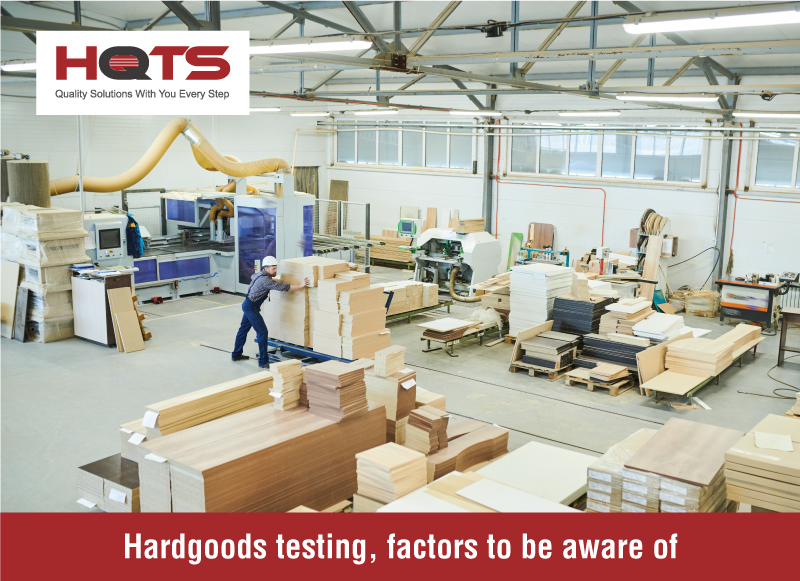Hardgoods cover a wide area of products. A simple definition of them is goods aimed at being durable and last an extended period. Examples of this can be wood, appliances, glassware, and more. For hardgood to be exported internationally, they must conform to their specific regulatory requirements, which is essential in this process.
This article aims to discuss the different types of hardgood testing depending on product type and factors that may assist your organization’s hardgoods quality control in the testing process.
What types of tests are available for hardgoods
There is a range of different tests available for hardgoods depending on their type. Some of these can include:
Glass and ceramics testing:
Glass products are a large percentage of products exported from china with an amount of 18.3 billion USD yearly, which equates to 25.1% of exported glass/glassware worldwide. Because of this, it is highly regulated depending on the country. These can include ISO ASTM and many more. Because of this, specific tests are needed to ensure the goods are of quality and safe for consumers. These can include:
Physical testing
Thermal shock testing:
Thermal shock testing is used to assess the product’s reaction to a rapid temperature change. This is done within a laboratory by using an oven to heat the glassware then plunging it into cold water. This is done several times until the glass breaks.
Annealing:
Annealing is a process of heat treatment that changes the product’s microstructure to allow for changes to its mechanical and electrical properties to assist in the amount of stress a product may take before shattering. Testing must ensure that products have undergone this process and to a regulatory standard.
Dishwasher/microwave test:
Glass products must also go through the physical process of being used in both a dishwasher and microwave to ensure they can withstand heat due to these being commonly used by consumers.
Absorption test:
This test is necessary to understand how much a product can absorb water over 15 minutes, as well as this can help define how much asbestos fibers have been retained also.
Chemical testing
EU/FDA food-grade testing:
Food grade testing relates to FCM’s or “food contact materials” that come into contact with food, such as glass and ceramic goods. For these goods to comply with these regulations, several tests must be undertaken. Such as: For ceramic and glass goods, testing must be used to assess the chemical components of the goods. This is to ensure that no harmful chemicals were used in their creation. This is since these goods will contact food that a consumer will eat. Chemicals that are commonly looked for include:
- Lead content on surface coating
- Lead and cadmium content.
Wood and wood products:
Wood products are commonplace in most consumer households, and safety is a priority. With many regulatory bodies, such as ASTM, EN, and GB, more research is needed for your specific products. However, common tests for these goods include:
Chemical testing:
Several chemicals are used in the production process when using wood or wood products. Because of this, to align with regulations, strict testing must be done to ensure that there is not a high amount of dangerous substances which could harm consumers. The chemicals which are tested for are:
- Formaldehyde
- PCP
- Cu, Cr, As
- Soluble lead
- Cadmium
- Chromium
- Mercury
- Volatile organic compounds (VOC)
- Azo dye content
- Pentachlorophenol (PCP) content
- Heavy metal analysis
- Flame retardant products
- Nickel release
- Phthalates
- Short-chain chlorinated paraffin (SCCPs)
- HAP
Testing is essential to ensure there are no high amounts of these chemicals. If the products do have them, they will not comply with regulations and cannot be exported.
Candle testing
Another example of a hardgood product which testing is essential to their export is candles. These products produce a flame and therefore pose a potential risk to consumers. Several tests are put in place to ensure that they are not only of quality but safe also. These include:
- Warning label check
- Candles burning safety
- Flame height
- Other ignition
- End of useful life
- Candle stability
- Candle container compatibility and burner
- Sharp temperature change proof of candle container
- Thermal Shock
- Lead content of wick
These tests ensure that the candle is not filled with harmful chemicals or built that the flame will reach too high. If these do not comply, there is a fire risk that could have catastrophic consequences.
Why is testing important for hardgood products
Due to the nature of hardgood products, quality and longevity are a requirement for consumers and regulatory bodies. Testing ensures that these standards are upheld and assists in protecting the brand image from the negative repercussions of faulty or dangerous products. Implementing a 3rd party hardgood inspection/testing process will significantly increase your supply chain effectiveness and speed to market. Without it, goods may fail to reach regulation and be either destroyed or sent back, creating significant delays or even wholly disrupting your supply chain infrastructure.
About AQM BD
AQM BD has over 25 years of experience as a 3rd party quality assurance organization, serving various industries and clients, including testing services for hardgood products. We pride ourselves in high quality, a smooth process that aims to strengthen and smoothen your organization’s supply chain. With testing facilities worldwide, we can assist in giving robust and insightful reports on the quality of your goods to ensure it complies with regulatory bodies. Contact us today to find out more.





